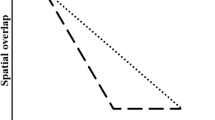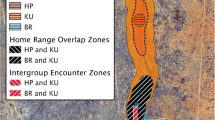Abstract
Intraspecific competition is a key factor shaping space-use strategies and movement decisions in many species, yet how and when neighbors utilize shared areas while exhibiting active avoidance of one another is largely unknown. Here, we investigated temporal landscape partitioning in a population of wild baboons (Papio cynocephalus). We used global positioning system (GPS) collars to synchronously record the hourly locations of five baboon social groups for ∼900 days, and we used behavioral, demographic, and life history data to measure factors affecting use of overlap areas. Annual home ranges of neighboring groups overlapped substantially, as predicted (baboons are considered non-territorial), but home ranges overlapped less when space use was assessed over shorter time scales. Moreover, neighboring groups were in close spatial proximity to one another on fewer days than predicted by a null model, suggesting an avoidance-based spacing pattern. At all time scales examined (monthly, biweekly, and weekly), time spent in overlap areas was greater during time periods when groups fed on evenly dispersed, low-quality foods. The percent of fertile females in social groups was negatively correlated with time spent in overlap areas only during weekly time intervals. This suggests that broad temporal changes in ecological resources are a major predictor of how intensively overlap areas are used, and groups modify these ecologically driven spacing patterns at short time scales based on female reproductive status. Together, these findings offer insight into the economics of territoriality by highlighting the dynamics of spacing patterns at differing time scales.



Similar content being viewed by others
References
Alberts SC, Altmann J (1995) Balancing costs and opportunities: dispersal in male baboons. Am Nat 145:279–306
Alberts SC, Hollister-Smith J, Mututua RS, Sayialel SN, Muruthi PM, Warutere JK, Altmann J (2005) Seasonality and long-term change in a savanna environment. In: Brockman DK, van Schaik CP (eds) Seasonality in primates: studies of living and extinct human and non-human primates. Cambridge University Press, Cambridge, pp 157–195
Altmann SA (1974) Baboons, space, time, and energy. Am Zool 14:221–248
Altmann J (1980) Baboon mothers and infants. Harvard University Press, Cambridge
Altmann SA (1998) Foraging for survival: yearling baboons in Africa. University of Chicago Press, Chicago
Altmann J (2000) Predicting male distribution among primate groups. In: Kappeler P (ed) Primate males: causes and consequences of variation in group composition. Cambridge University Press, New York, pp 236–247
Altmann SA (2009) Fallback foods, eclectic omnivores, and the packaging problem. Am J Phys Anthropol 140:615–629
Altmann SA, Altmann J (1970) Baboon ecology. University of Chicago Press, Chicago
Altmann J, Muruthi P (1988) Differences in daily life between semiprovisioned and wild-feeding baboons. Am J Primatol 15:213–221
Altmann J, Schoeller D, Altmann SA, Muruthi P, Sapolsky RM (1993) Body size and fatness of free-living baboons reflect food availability and activity levels. Am J Primatol 30:149–161
Beehner JC, Onderdonk DA, Alberts SC, Altmann J (2006) The ecology of conception and pregnancy failure in wild baboons. Behav Ecol 17:741–750
Begon M, Townsend CR, Harper JL (2005) Ecology: from individuals to ecosystems, 2nd edn. Blackwell, Oxford
Bentley-Condit V, Smith EO (1997) Female reproductive parameters of the Tana River yellow baboons. Inter J Primatol 18:581–596
Bercovitch FB, Harding RSO (1993) Annual birth patterns of savanna baboons (Papio cynocephalus anubis) over a ten-year period at Gilgil, Kenya. Folia Primatol 61:115–122
Börger L, Dalziel BD, Fryxell JM (2008) Are there general mechanisms of animal home range behaviour? A review and prospects for future research. Ecol Lett 11:637–650
Box GEP, Jenkins GM, Reinsel GC (2008) Time series analysis: forecasting and control. Wiley, New York
Boyce MS, Pitt J, Northrup JM, Morehouse AT, Knopff KH, Cristescu B, Stenhouse GB (2010) Temporal autocorrelation functions for movement rates from global positioning system radiotelemetry data. Philos T R Soc B 365:2213–2219
Brockwell PG, Davis R (1991) Time series: theory and methods, 2nd edn. Springer, New York
Brown JL (1964) The evolution of diversity in avian territorial systems. Wilson Bull 76:160–169
Burt WH (1943) Territoriality and home range concepts as applied to mammals. J Mammal 24:346–352
Cairns SJ, Schwager SJ (1987) A comparison of association indices. Anim Behav 35:1454–1469
Chapman CA, Chapman LG, McLaughlin RL (1989) Multiple central place foraging by spider monkeys: travel consequences of using many sleeping sites. Oecologia 79:506–511
Cheney DL, Seyfarth RM (1977) Behaviour of adult and immature male baboons during inter-group encounters. Nature 269:404–406
Cheney DL, Seyfarth RM (1983) Non-random dispersal in free-ranging vervet monkeys: social and genetic consequences. Am Nat 122:392–412
Davies NB (2000) Multi-male breeding groups in birds: ecological causes and social conflict. In: Kappeler PM (ed) Primate males: causes and consequences of variation in group composition. Cambridge University Press, Cambridge, pp 11–20
Doncaster CP (1990) Non-parametric estimates of interaction from radio-tracking data. J Theor Biol 143:431–443
Emlen ST, Oring LW (1977) Ecology, sexual selection, and the evolution of mating systems. Science 197:215–223
Esau K (1965) Plant anatomy. Wiley, New York
Estes RD (1991) The behavior guide to African mammals. University of California Press, Berkeley
Fischer J, Hammerschmidt K, Cheney DL, Seyfarth RM (2002) Acoustic features of male baboon loud calls: influences of context, age, and individuality. J Acoust Soc Am 111:1465–1474
Fritsch FE, Salisbury E (1965) Plant form and function. G Bell and Sons, London
Gehrt SD, Fritzell EK (1998) Resource distribution, female home range dispersion and male spatial interactions: group structure in a solitary carnivore. Anim Behav 55:1211–1227
Gesquiere LR, Wango EO, Alberts SC, Altmann J (2007) Mechanisms of sexual selection: sexual swellings and estrogen concentrations as fertility indicators and cues for male consort decisions in wild baboons. Horm Behav 51:114–125
Gesquiere LR, Khan M, Shek L, Wango TL, Wango EO, Alberts SC, Altmann J (2008) Coping with a challenging environment: effects of seasonal variability and reproductive status on glucocorticoid concentrations of female baboons (Papio cynocephalus). Horm Behav 54:410–416
Gesquiere LR, Onyango PO, Alberts SC, Altmann J (2011) Endocrinology of year-round reproduction in a highly seasonal habitat: environmental variability in testosterone and glucocorticoids in baboon males. Am J Phys Anthropol 144:169–176
Hamilton WJ III (1982) Baboon sleeping site preferences and relationships to grouping patterns. Am J Primatol 3:41–53
Harcourt AH (1987) Dominance and fertility among female primates. J Zool 213:471–487
Hausfater G, Meade BJ (1982) Alternation of sleeping groves by yellow baboons (Papio cynocephalus) as a strategy for parasite avoidance. Primates 23:287–297
Hoset KS, Le Galliard J-F, Gundarsen G, Steen H (2008) Home range size and overlap in female root voles: effects of season and density. Behav Ecol 19:139–145
Hutchinson JMC, Waser PM (2007) Use, misuse and extensions of “ideal gas” models of animal encounter. Biol Rev 82:335–359
Ims RA (1987) Male spacing systems in microtine rodents. Am Nat 130:475–484
Janmaat KRL, Olupot W, Chancellor RL, Arlet ME, Waser PM (2009) Long-term site fidelity and individual home range shifts in Lophocebus albigena. Int J Primatol 30:443–466
Jensen SP, Gray SJ, Hurst JL (2005) Excluding neighbours from territories: effects of habitat structure and resource distribution. Anim Behav 69:785–795
Kitchen DM, Cheney DL, Seyfarth RM (2004) Factors mediating inter-group encounters in savannah baboons (Papio cynocephalus ursinus). Behaviour 141:197–218
Lambin X, Krebs CJ (1991) Spatial organization and mating system of Microtus townsendii. Behav Ecol Sociobiol 28:353–363
Macdonald DW, Ball EG, Hough NG (1980) The evaluation of home range size and configuration using radiotracking data. In: Amlaner CJ, Macdonald DW (eds) A handbook on biotelemetry and radio tracking. Pergamon, Oxford, pp 405–425
Markham AC, Altmann J (2008) Remote monitoring of primates using automated GPS technology in open habitats. Am J Primatol 70:495–499
McLaughlin RL, Montgomerie RD (1989) Brood dispersal and multiple central place foraging in Lapland longspur parents. Behav Ecol Sociobiol 25:207–215
McLoughlin PD, Gaillard J-M, Boyce MS, Bonenfant C, Messier F, Duncan P, Delorme D, Van Moorter B, Saїd S, Klein F (2007) Lifetime reproductive success and composition of the home range in a large herbivore. Ecology 88:3192–3201
Melnick DJ, Pearl MC (1987) Cercopithecines in multi-male groups: genetic diversity and population structure. In: Smuts BB, Cheney DL, Seyfarth R, Wrangham RW, Struhsaker TT (eds) Primate societies. University of Chicago Press, Chicago, pp 121–134
Nathan R, Getz WM, Revilla E, Holyoak M, Kadmon R, Saltz D, Smouse PE (2008) A movement ecology paradigm for unifying organismal movement research. P Natl Acad Sci USA 105:19052–19059
Nemtzov SC (1997) Intraspecific variation in home range exclusivity by female green razorfish, Xyrichtys splendens (family Labridae), in different habitats. Environ Biol Fishes 50:371–381
Norton GW, Rhine RJ, Wynn GW, Wynn RD (1987) Baboon diet: a five-year study of stability and variability in the plant feeding and habitat of the yellow baboons (Papio cynocephalus) of Mikumi National Park, Tanzania. Folia Primatol 48:78–120
Olupot W, Waser PM (2001) Correlates of intergroup transfer in male grey-cheeked mangabeys. Int J Primatol 22:169–187
Ostro LET, Young TP, Silver SC, Koontz FW (1999) A geographic information system method for estimating home range size. J Wildl Manage 63:748–755
Packer C (1979) Inter-troop transfer and inbreeding avoidance in Papio anubis. Anim Behav 27:1–36
Pinheiro JC, Bates DM (2000) Mixed-effects models in S and S-PLUS. Springer, New York
Pulliainen E (1984) Use of the home range by pine martens (Martes martes L.). Acta Zool Fennica 171:271–274
Pulliam HR, Caraco T (1984) Living in groups: is there an optimal group size? In: Krebs HR, Davies N (eds) Behavioural ecology. Blackwell Scientific, Oxford, pp 122–147
Reynolds TD, Laundré JW (1990) Time intervals for estimating pronghorn and coyote home ranges and daily movements. J Wildl Manage 54:316–322
Rubenstein DI (1981) Behavioural ecology of island feral horses. Equine Vet J 13:27–34
Sapolsky RM, Altmann J (1991) Incidence of hypercortisolism and dexamethasone resistance increases with age among wild baboons. Biol Psychiat 30:1008–1016
Schoener TW (1987) Time budgets and territory size: some simultaneous optimization models for energy maximizers. Am Zool 27:259–291
Shopland JM (1982) An intergroup encounter with fatal consequences in yellow baboons (Papio cynocephalus). Am J Primatol 3:263–266
Tabachnick BG, Fidell LS (2006) Using multivariate statistics, 5th edn. Allyn and Bacon, New York
Whitten PL (1983) Diet and dominance among female vervet monkeys (Cercopithecus aethiops). Am J Primatol 5:139–159
Acknowledgements
We are grateful to the government of the Republic of Kenya, to the Kenya Wildlife Services, the staff and wardens of Amboseli National Park, and the local community of the Amboseli region. Tremendous thanks go to ABRP researchers for their contributions to data collection and outstanding dedication in the field: R. Mututua, S. Sayialel, J.K. Warutere, G. Marinka, B. Oyath, and I. Longida. We also thank M. Akinyi, L. Gesquiere, N. Learn, and L. Maryott for their invaluable assistance. T. Garin and Advanced Telemetry Systems, Inc. provided exceptional product support. I. Couzin, A. Dobson, D. Rubenstein, P. Waser, and M. Wikelski commented on an earlier draft of this manuscript. Financial support was provided by American Society of Primatologists (to A.C.M.), Animal Behavior Society (to A.C.M.), International Primatological Society (to A.C.M.), Max Planck Institute of Ornithology (to M. Wikelski), National Institute on Aging (R01AG034513-01 to J.A. and S.C.A.), National Science Foundation (IBN-0322613 to J.A. and S.C.A.; IOS-0919200 to S.C.A.; BCS-0851750 to J.A. and A.C.M.), and Sigma Xi (to A.C.M.). Support data from this project are available in the Dryad database.
Ethical standards
All project protocols complied with regulations in Kenya (Republic of Kenya Research Permits NCST/5/002/R/776 to J.A. and NCST/5/002/R/777 to S.C.A.) and in the USA (Princeton University IACUC 1649).
Author information
Authors and Affiliations
Corresponding author
Additional information
Communicated by D. P. Watts
Rights and permissions
About this article
Cite this article
Markham, A.C., Guttal, V., Alberts, S.C. et al. When good neighbors don't need fences: temporal landscape partitioning among baboon social groups. Behav Ecol Sociobiol 67, 875–884 (2013). https://doi.org/10.1007/s00265-013-1510-0
Received:
Revised:
Accepted:
Published:
Issue Date:
DOI: https://doi.org/10.1007/s00265-013-1510-0




